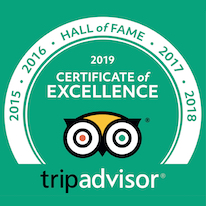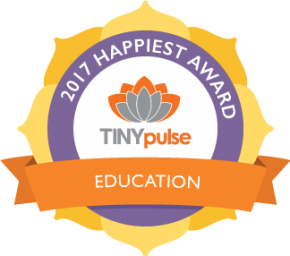Art. Central Axis. Retired. Village. “Li Nong.” High-Speed Railway. The Bund.
艺术。 中轴线。退休。农村。里弄。高铁。外滩。
by Jeffrey Schwab, Educational Programs Coordinator
These seven seemingly unrelated terms are the “mystery” words that I give, as a language exercise, to the students from the American School in London each morning after the students finish breakfast. I make the best use of my iPad and display the mystery word. The students copy down the day’s word in the Hutong Handbooks they carry with them everywhere during their six-day Chinese language immersion program. By the end of the program, the handbooks are full of Chinese characters and a few smudges of Beijing dust and soft drink stains from mealtimes.
The packed four days of Beijing programming covers sites such as 798, the Beijing Urban Planning Museum, Tiananmen Square, the Forbidden City, Jingshan Park, the Drum and Bell towers, a day in the hutongs, Chinese acrobats, the Temple of Heaven and the Temple of Earth. The students’ energy is high as we take it all in. We depart from Beijing on the high speed rail to Shanghai to explore the city’s “li nong” neighborhoods, visit the Zhujiajiao watertown, participate in a school exchange with students from Shanghai American School, view the Propaganda Poster Art Center, and finally take a walk to the Bund. Each and every aspect of the program has a Chinese language focus and every student is required during their time in China to give at least one Chinese speech (usually at meal times) summing up the day’s events.
“I cannot give you any hint about the mystery Chinese terms for each day,” I say to the students as I hold up my iPad with the characters 艺术, meaning “Art.”
“The only thing I can tell you is that each day’s theme will be focused on the mystery terms that I introduce in the morning. By the end of the day, you will definitely have a good concept of what these terms mean.”
All of the students on the program have Chinese names. The head teacher, Chris Chen, is from Taiwan and speaks to the students mostly in Chinese. The supporting teacher, Nina De Simone, is a Spanish instructor, but by the end of the trip, she has definitely expanded her foreign language capabilities to include rudimentary Chinese.
After the first day’s events at the 798 Art District, the students ask me on the second day what the mystery word will be. 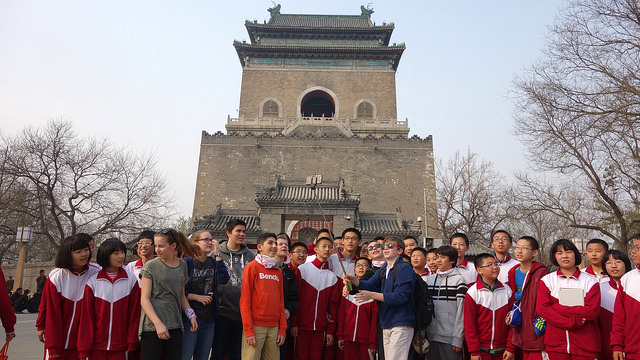 They
They
dared me to challenge them with new Chinese phrases. The second day is really a marathon, as the mystery term is “Central Axis” or 中轴线. We walk a good portion of Beijing’s Central Axis all the way from the Urban Planning Museum to the Drum and Bell tower. We stop along the way for a tour of the Forbidden City, (or 故宫 gugong as the students’ know it). After lunch and a brief soccer break in Jingshan Park, we have an energetic encounter with students from Beijing #13 Middle School in the middle of the Drum and Bell Tower Square. After leaving the square, I give one of the students enough money to buy metro tickets for all of us.
Besides the seven mystery terms, students are encouraged to challenge themselves. So after leaving the square, I give one of the students enough money to buy metro tickets for all of us. “Now this is a real life challenge. When in Beijing, do as the Beijingers do.” The student does the talking and purchasing, coming back with the right change, the tickets and a big smile! Another task requires students to ask local residents questions and there are structured activities to engage in conversation each day. On the day we visited both the Temple of Heaven and the Temple of Earth, the mystery term was “retired.” Students were given the task to interview locals. When they proceed with their interviews, the mystery term gradually dawns on the students as they realize that the age of most of the people in Beijing parks is over 60 years old. Despite having trouble with the Beijing accent, the structured interviews in the parks boost confidence in the students’ Chinese language ability, and make China’s colossal capital more welcoming to 13 and 14 year olds from abroad.
On Beijing’s final day, we visit the Great Wall at Mutianyu, followed by lunch in the nearby “village” 农村 (one of the mystery words) of Tianxianyu 田仙峪。The proprietor, Mr. Ge, and his wife join us on the sun deck of their home for conversation after the meal. Rather than having the chosen “speaker” give a speech that day, the student named “Shan Mi” (Chinese name) took questions from the group to ask Mr. Ge on the roof after lunch. Mr. Ge is duly impressed with the students’ efforts at communication, as he answers questions about village life and his hobby of carpentry in which he get paid for surveys on occasion.
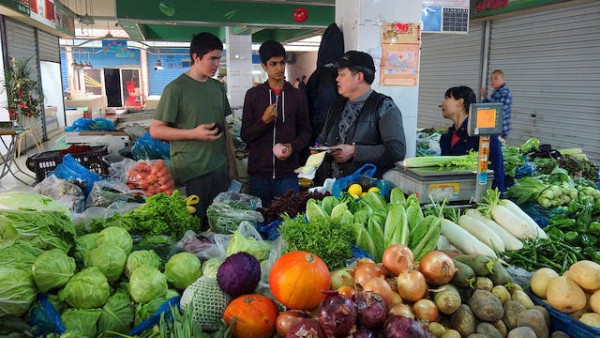
When the program takes a turn south to Shanghai, we hit the ground running, after exiting the high speed rail 高铁, and immediately head to Shanghai’s Former French Concession so students can explore the “Shikumen” (stone archway housing) as well as the “li nong” 里弄。 There isn’t a very good English translation for “li nong.” They are akin to Shanghai’s version of hutongs, with double or triple story housing dating back to the late Qing dynasty. We visit a museum dedicated to the history of Shanghai’s old district and are welcomed at a Mandarin Language school located in heritage architecture formerly belonging to a banker in the 1920s. The teachers in the Mandarin school show the students around the old house and explain that one of the rooms is named after a Japanese student who had taken 3,000 hours of classes with them.
On the second day in Shanghai, students visit the Shanghai American School and meet with their counterparts who show them how studying Chinese in China has its benefits. Visiting a local market across the street from the school, ASL and SAS students pair up to haggle for fruits and vegetables before we board the bus to drive to Zhujiajiao water town for lunch and exploration. The Zhujiajiao lunch is one of the selected three meals where students split into small groups, are given a budget from The Hutong, and then must face the possibly daunting task of having to order their own meal in order to feed the group. The group I sit with is lucky as they order two entire chickens for the table!
The final activity of the program involves visiting the Propaganda Poster Art Museum in Shanghai. Discreetly hidden in the 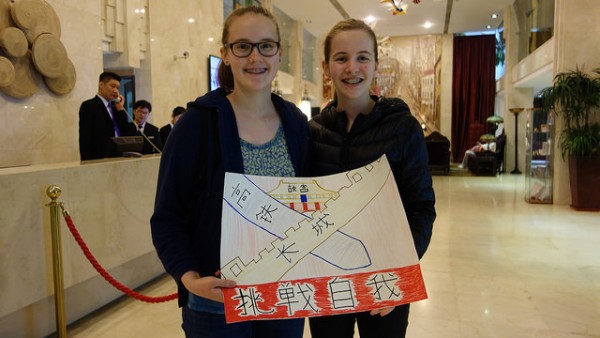 basement of an apartment complex, getting to the museum is almost as fun as the museum itself. Filled with posters of American Capitalists, British Imperialists, and Soviet Revisionists, the museum is an excellent location for students to create their own propaganda posters for future ASL students. Using expressions they have gathered throughout the week in Beijing and Shanghai, students design colorful works of art and introduce them in Chinese in pairs incorporating Hutong Core values of seeking challenge and embracing diversity. Students take risks with words they’ve never used before and learn phrases in real-time as they present to the group.
basement of an apartment complex, getting to the museum is almost as fun as the museum itself. Filled with posters of American Capitalists, British Imperialists, and Soviet Revisionists, the museum is an excellent location for students to create their own propaganda posters for future ASL students. Using expressions they have gathered throughout the week in Beijing and Shanghai, students design colorful works of art and introduce them in Chinese in pairs incorporating Hutong Core values of seeking challenge and embracing diversity. Students take risks with words they’ve never used before and learn phrases in real-time as they present to the group.
As we walk to the Bund late that evening (final mystery word 外滩 waitan meaning “Bund”) this group from ASL navigates its boardwalk and wharves with confidence. Their handbooks are mostly unbound by now, the covers half falling off, the pages filled with notes scratched out, characters written over characters, each and everyone of the students taking the time and effort to “seek challenge” and “embrace the diversity” of using Chinese with their peers, with “Old Beijing” locals, with strangers in the street, with wait staff in restaurants, and even with fast talking Shanghai-ers.


